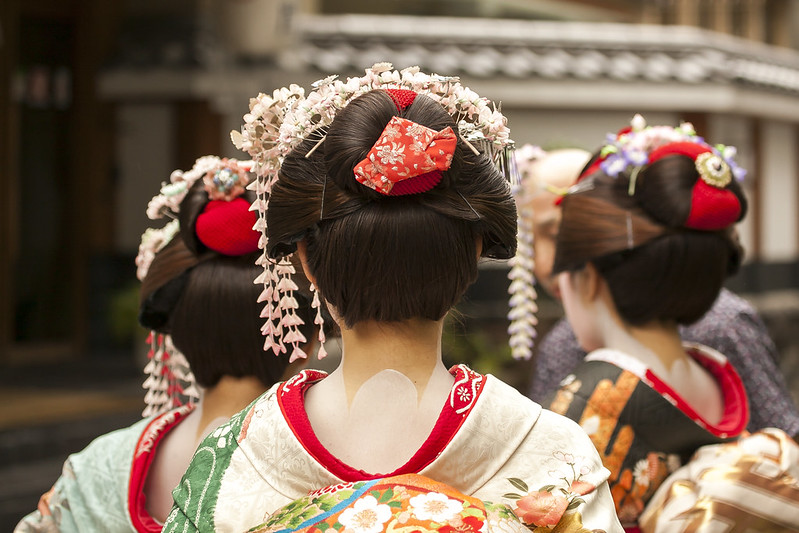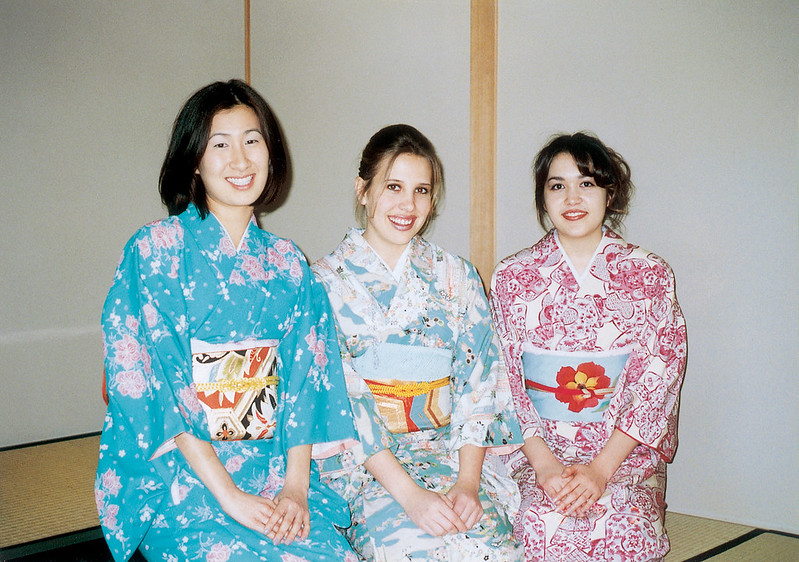
All About the Kimono
The kimono (着物) is a traditional costume worn by Japanese women, men, and children. Today, the kimono denotes a full length T-shaped robe with straight lines. It’s worn so that the hem falls at the ankle and has collars and wide, long sleeves. The kimono wraps around the body, with the left side on top of the right (except when dressing for a burial), and is secured with an obi (sash) tied at the back. With a kimono, one wears traditional Japanese footwear (geta or zori) and split toe socks called tabi.
The kimono is often worn by women and for special occasions. Unmarried women traditionally wear the furisode, a kimono with floor-length sleeves. Men wear kimonos during tea ceremonies, weddings, and other special occasions.
KCP students in kimonos. | KCP Flickr
History
The earliest kimono styles were significantly influenced by Han Chinese clothing, popular today as hanfu (漢服). The sleeves of the kimono began to grow in length during the Edo Period, especially for single women, and the obi became wider. Since then the shape of the kimono has remained unchanged. As a result of Emperor Meiji’s edict, railroad men, police, and teachers adapted to Western clothes. After the Kanto earthquake disaster in 1923, kimono wearers were the victims of frequent robberies, since they couldn’t run properly in such clothes and slippers. Today, most people wear Western clothing and turn to the more comfortable and breezier yukata(a summer kimono) for special events.
Layering
The meanings of kimono layering and hiyoku (a floating lining or under-kimono) are no longer practiced. Only geisha and maiko use the layering technique for subtle erotic suggestions and dances, usually emphasizing the back of the neck.
Most modern Japanese brides wear the Shinto kimono, usually with a hiyoku. In the past, kimonos were worn with hiyoku. Old-fastioned kimonos have an entire under-kimono, but, contemporary layers are only partial, to give the impression of layering.
Kimono diagram. | Steveh87
Anatomy of a Kimono
The kimono has several parts, each with its own name.
- Eri or collar
- Furi or below-armhole sleeve.
- Doura or upper lining
- Sode or sleeve
- Sodetsuke or sleeve opening
- Fuki or hemguard
- Tamoto or sleeve pouch
- Uraeri or inner collar
- Sodeguchi or sleeve opening
- Maemigoro or the front main panel
- Ushiromigoro or the back panel
Care
The traditional method of washing kimonos is called arai hari. Stitches were usually taken out during washing and then hand sewn again for wearing. Arai hari is a difficult and expensive way of caring for kimonos and is a major factor in its decline. Modern cleaning methods and fabrics have eliminated this need, but most high-end kimonos are still cared for that way. Like any other traditional garment, the kimono is folded in specific ways, helping preserve it and keep it from creasing when stored. Kimonos are usually wrapped in tatoshi paper.


